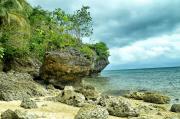
The Bohol Bee Farm is an agriculture haven situated on top of a cliff on Panglao Island, Bohol, dedicated to bee cultivation, organic farming, and healthy eating. Aside from growing diverse agricultural produce, Bohol Bee Farm also houses a resort and a restaurant where visitors can take a time off from the city and find relaxation while providing livelihood to the local residents.
Simple Beginnings
In the late 1980s, New York-based nurse Victoria Wallace decided to return to the Philippines after her husband had died. Wallace went back to the country with her children and purchased a nominal piece of land where she grew vegetables, which she sold to her children's classmates. Parents with foreign spouses harvested their own vegetables at her farm. Wallace also started selling bread that was not too sweet to suit the palates of her foreign neighbors.
Soon, Wallace hired four workers to help with the small business that she began in 2001. Eight years later, the business expanded into a growing enterprise with 232 employers, most of them women.
Bohol Bee Farm Today
The farm now prides itself as a hidden sanctuary for agricultural development and leisure. Its 4.8-hectare site consists of a farm with 60 colonies of honey bees, organic gardens, and a lounge area. Guests are accommodated in The Barn and Garden Bungalow budget rooms, Beehive Suites, Banana Room, Honeycomb Suites, and Colony Suites.
- Buzz Café – In 2008, the farm took its ventures into the city and opened the Buzz Café at Island City Mall in Tagbilaran.
- The farm restaurant has a wide array of natural and organically grown food that includes pure honey, honey spread, honey mustard salad dressing, herb bread (a favorite among foreign visitors), kamote bread (preferred by Filipinos), squash muffins, gumamela hot tea, vegetable lasagna, brewed coffee from roasted corn, honeyed halo-halo, and spicy flower salad.
- Bohol Bee Farm also supports different livelihood projects such as soap making, organic vegetable farming, and raffia crafts. The products are made, displayed, and used in the farm, which, according to Wallace, is their way of finding markets.
In 2003, Bohol Bee Farm started a scholarship program that provided support to the children of its employees. Wallace said that the first three children whom the program helped are now graduates; two have become teachers and are taking their master's degree. She added that a livelihood academy is also in the works for those who want to establish a similar business.




Bokeh Flower at Bee Farm
Fun at Bohol Bee Farm
In Bohol Bee Farm, guests can bathe in its two-tiered swimming pool, go for a dolphin and whale-watching tour, or enjoy a traditional massage at the Hilot Area, facing the sea. The farm also has a restaurant that offers catering services and a function area with audio-visual facilities.
Visitors can also try raffia weaving, furniture making, sewing, paddling, basket making, bee culture, and organic farming. Farm staff also gives guests a tour of the farm, and a lecture on different organic farming methods and on how bees are taken care of to produce honey.
Going to Bohol Bee Farm
From Manila, just take a flight to Tagbilaran, which takes about a little over an hour. It is also possible to take a boat to Bohol, but will take 25 hours, and is only advisable if you have plenty of time at hand and enjoy a trip on sea, or have to travel on a rock-bottom budget or with a lot of luggage. Currently, there are numerous daily flights from Manila to Tagbilaran.
From Tagbilaran pier or airport there are many means of transportation you can take to go to Bohol Bee Farm - Dao, Dauis, Panglao. Metered taxis are the safest. But for those who love adventure, you can opt for the tricycles (motorbikes with sidecar) or the habal-habal (motorbikes that can take four people the least).










